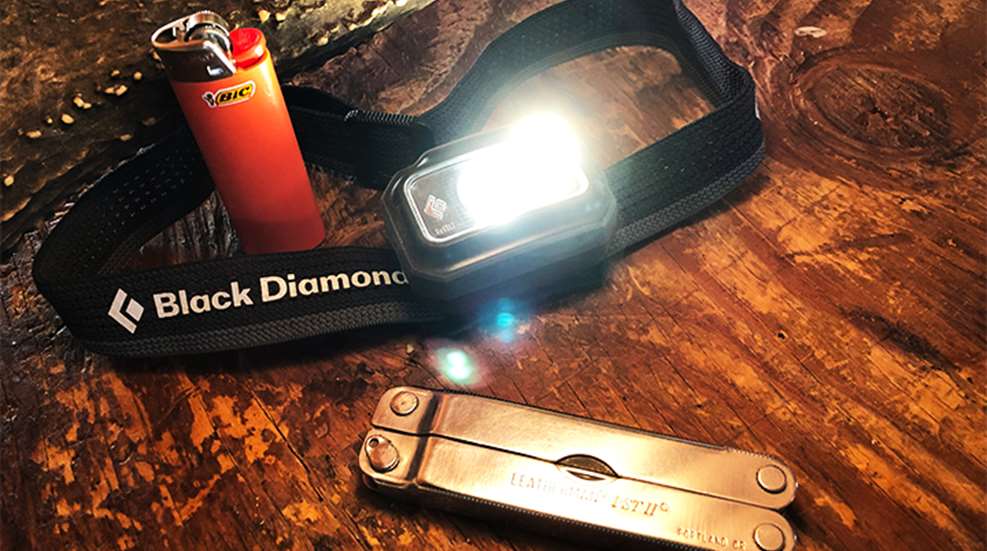
There are three tools I never go hunting without. With them I can stay safe and alive in almost any outdoor circumstance. They are a multitool, a fire-starter and a light. Here’s why you should carry them too, and how you can put each to use.
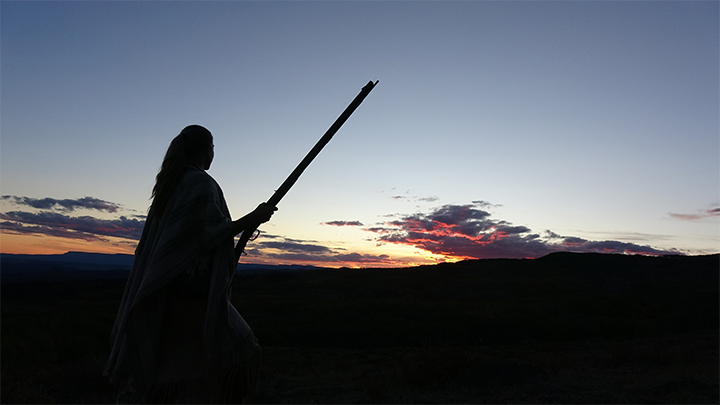
Headlamp
Light shown through the canopy of aspens, but down here on the ground it was almost dark. The scent of rutting elk drove me onward, my recurve grasped tightly in my hand. Trunks of downed trees lay tumbled about like match sticks thrown by some giant hand, making progress difficult. The terrain was steep, too. So steep that in places it was like lowering myself down through a crazy morass of twisted monkey bar tree trunks. Seeps broke out of the hillside in profusion, adding slippery mud and boggy pockets to the already treacherous footing. It was the kind of spot elk love to go when hunter pressure is on and they need a good place to disappear.
Not 15 minutes earlier, I’d seen several elk dive into this mountainside copse of quakies. The evening sun had set and dusk was looming, but I threw caution to the winds and went into the timber after the elk. The problem was, I didn’t have a light. Getting out of that mess of timber after dark was going to be a chore.
The canopy was now dark, and here on the ground it was almost pitch black. The white aspen trunks shown ghostlike, but I could not see my knees, let alone my feet. Feeling my way, I crawled, lurched and staggered down the steep slope. Frustrated and scared, I tried to hurry. My feet were spread, tenuously perched on two different logs when I fell for the umpteenth time. Plunging forward, I tried to protect my bow from damage. My left leg jammed between two deadfall trunks as I pitched down the slope, and I felt a groan wrench from me as the bones in my leg creaked and my knee over-extended. Unsure how bad I was hurt, I hung there grunting for breath, head downslope, hands searching in the darkness for support.
I found a couple logs and performed an emergency inverted pushup, trying to relieve the strain on my trapped leg. Desperately, I fought the deadfall, the darkness and the trap that held my leg on the thin edge of breaking. Finally, I managed to extricate myself, found a seat on a log and gathered up my bow. Heaving for breath I sat on that log and made myself a promise; never again would I enter the woods without a light. Gone was the frustration and rush to make my way out of the timber, replaced now by a cold knowledge that I had just barely escaped a real backcountry problem. Taking my time and favoring my injured (but not broken) leg, I felt my slow way downslope and out of the woods.
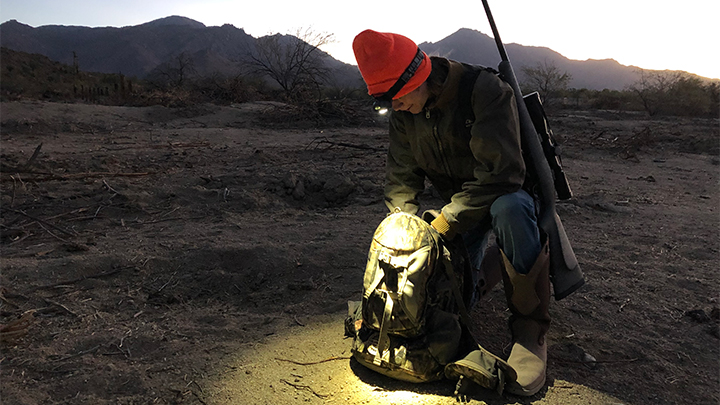
I always carry a headlamp in the cargo pocket on my pants anytime and every time I go hunting. That way I always have a light. I carry a backup headlamp in my backpack.
Headlamps excel for our needs as hunters because they offer hands-free illumination. Good models are waterproof, adjustable, lightweight and comfortable. They’ll offer three or more illumination settings, allowing you to conserve battery when possible, or use a bright beam if you need it. Black Diamond and others offer models that use a rechargeable battery or AAA batteries interchangeably. I like having that option.
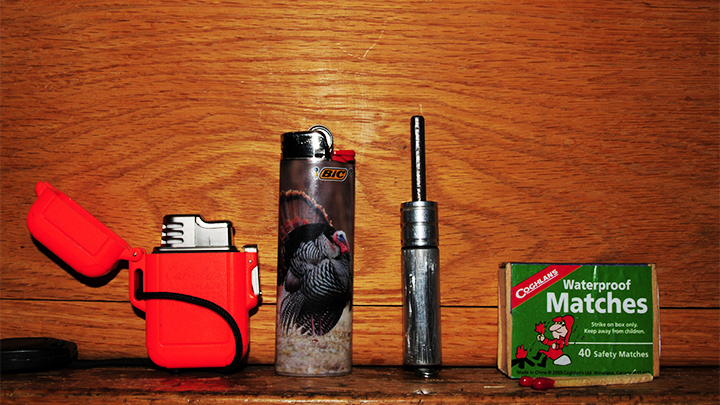
Fire Starter
The Alaskan creek roared and frothed around a corner and out of sight. My hunting buddy Greg paddled frantically as his raft was swept by the swift current into a huge mat of overhanging willow sweepers, but to no avail. The willows grabbed him, crumpled him into an agonizing backflip and forced him under the raging water. I was working desperately to avoid the same fate when his head popped above water and he lunged shoreward, catching the rope trailing his raft and lining it to the gravel bank. He was alive, but now hypothermia threatened. I avoided the willow sweepers and paddled to shore, then quickly built a fire on a gravel bar as he disrobed. We hung his clothing and waders on brush and around the fire for several hours. Once his clothing was warm and mostly dry, we resumed our float down the creek.
The main reason to carry a fire starter is, of course, to start a fire. In some cases, getting a fire going can mean the difference between life and death. I have been so cold in the backcountry, my boots frozen to my feet, that a fire was the only thing that could warm me. (On that note, you should practice building fire. It’s a learned skill, and the time to learn it is not when you’re fighting for your life against the cold.)
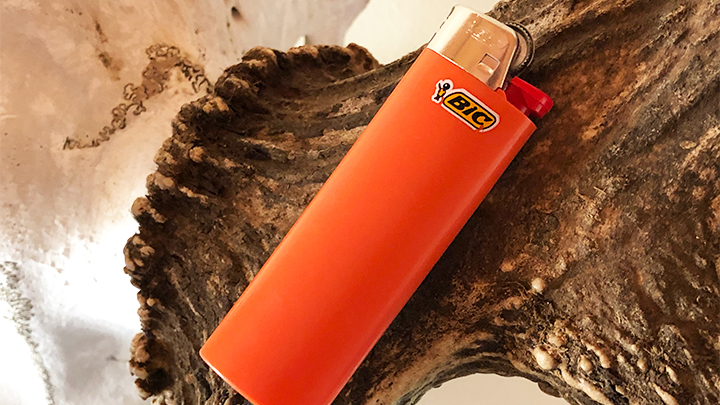
I personally like a simple but good quality cigarette lighter (you know, the two-dollar version rather than the .79 cent kind). They’re easy to use, dependable and comfortable to carry in your pocket. You can substitute a compact waterproof match case, or wind-proof lighter, or any other good fire-starter if you prefer. I carry one in my pocket, and a more complete fire-starting kit that includes waterproof matches and a second lighter in my pack.
If you are in an area where fires are hard to start (damp or high elevation) it’s also a good idea to carry some kind of tinder in your pocket. A Vaseline-impregnated cotton ball, a Fire Brick, or similar is perfect.
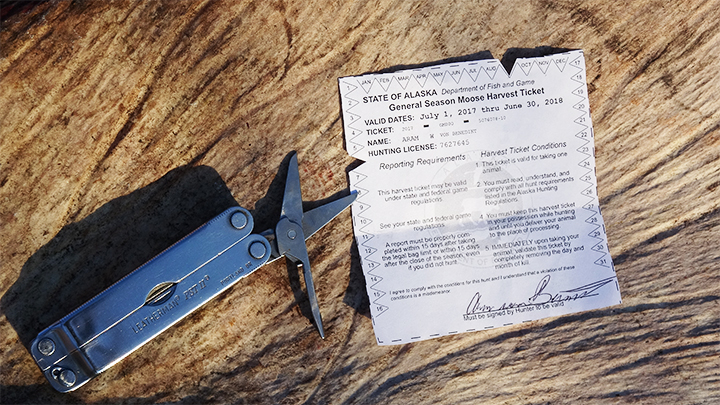
Multi-Tool
Just over a small ridge was a well-used bear bait. Bear sign was everywhere, the dirt torn up like someone had been dragging main in a bulldozer. Headed in to check the spot for a friend, I levered the action on a rifle I carried for protection. The leaver stuck. Glancing down, I could see a cartridge jammed awkwardly inside the action. Bear sign was everywhere and evening was coming on; not a good time to have my rifle go belly up.
Dropping to my knees in a small glade, I slipped my Leatherman from its sheath and opened a flathead screwdriver. Quietly going to work, I kept an attentive eye on my surroundings. I removed the magazine tube, spring and follower, shook loose the errant cartridge, and reassembled the rifle. Tightening the last screw with the multitool, I carefully levered the action once more. This time a cartridge slid into the chamber. I couldn’t trust the rifle till I had a chance to fix it right, but at least I was back in business. Without the Leatherman I would have been reduced to carrying a pretty wood-and-metal club that looked like a rifle.
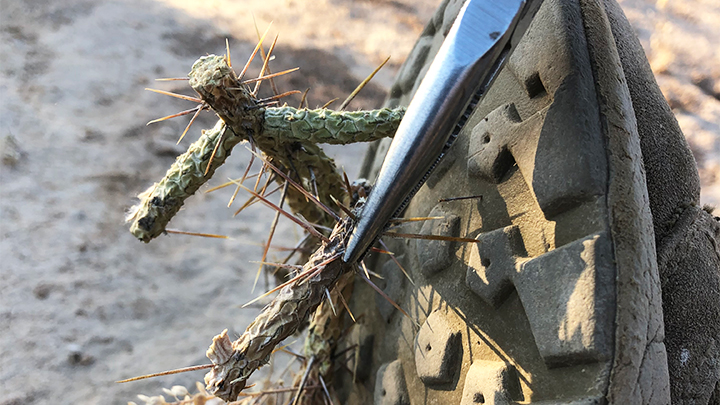
I’d rather give up my shirt than the multitool I always carry. I’ve worn out several over the years, and couldn’t begin to count the times they’ve come to my rescue. I’ve used them to cut wire away from entangled horses, butcher deer and extract wood splinters, porcupine quills and cactus spines. I’ve bored holes, sewn saddle tack and mended fence. I’ve notched hunting licenses, tightened doorknobs, poured coffee from a hot tin can, and built bow-drill fire-making sets. The list of ways a multitool can help out is endless.
The most important tools for a multitool to feature, in my opinion, are a good set of needle-nose pliers with wire cutters, a knife blade and screwdrivers—both flathead and Philips. I like having a pair of scissors, a can opener and a file, but those are secondary. Personally, I don’t use the really big multi-tool models (which sport enough tools to rebuild an engine), because they are too bulky and heavy to carry comfortably. I’ve always carried Leatherman brand multi-tools, but good models are available from Gerber and others, as well.
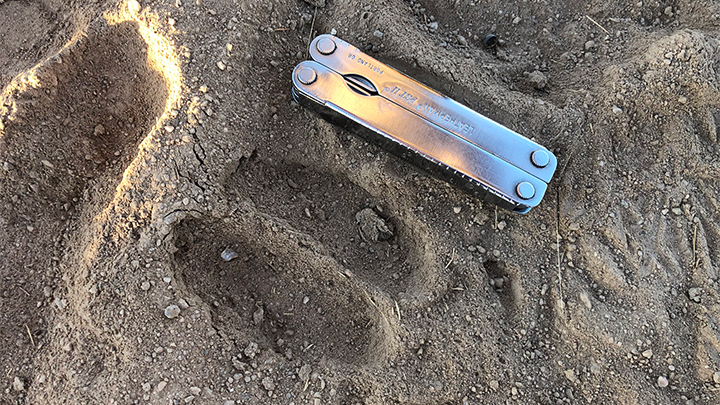
Conclusion
I’ve taught my kids this lesson, and I offer the same advice to you: anytime you head into the woods to fish, hike, hunt or anything else, carry a headlamp, a lighter and a multi-tool. With them, you can travel or work safely in the dark. You can start a fire to cook food, signal help or warm yourself. And you can make, whittle or repair almost anything you might need. Flavored with ingenuity, resourcefulness and common sense, these three tools are all you need to stay alive.


































